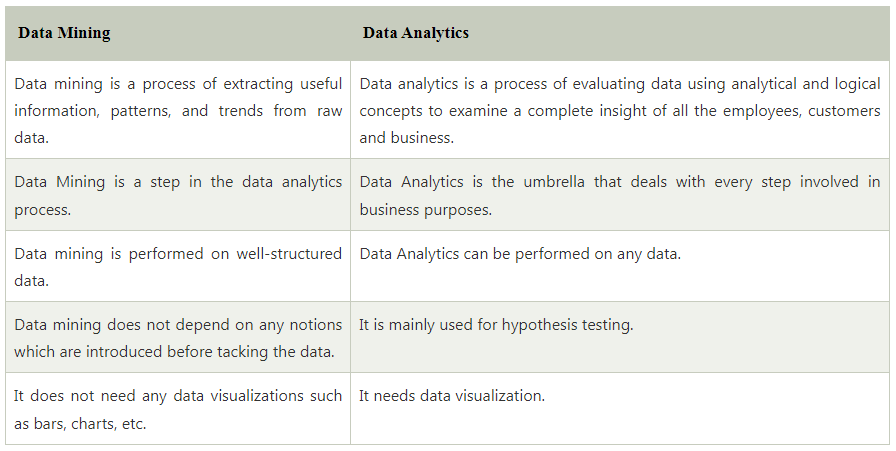Data analysis and data mining are a subset of business intelligence (BI), which also incorporates data warehousing, database management systems, and Online Analytical Processing (OLAP).
The technologies are frequently used in customer relationship management (CRM) to analyze patterns and query customer databases.
Large quantities of data are searched and analyzed to discover useful patterns or relationships, which are then used to predict future behavior.
Data mining is catering the data collection and deriving crude but essential insights. Data analytics then uses the data and crude hypothesis to build upon that and create a model based on the data.
Data mining is a step in the process of data analytics. Data Analytics is the umbrella which deals with every step in the pipeline of any data-driven model.
Data mining shines its brightest when the data in question is well structured. Meanwhile, data analysis can be performed on any data; it would still be able to derive meaningful insights that could help in propelling the corporation to even greater heights.
Data mining is tasked to accomplish the main job to make the data that is being used more usable. Whereas, data analysis is used to hypothesize and, in the end, culminate itself in providing valuable information to help in business decisions.
Data mining does not need any bias or any notions which are instilled before tackling the data. Whereas, data analysis is majorly used for hypothesis testing.
Data mining uses the scientific and mathematical models and methods to identify patterns or trends in the data that is being mined. On the other hand, data analysis is employed to task with business analytics problems and derive analytical models.
Data mining usually does not need any visualizations, bar charts, graphs, GIPs, etc., whereas these visualizations /are the bread and butter of data analysis. Without a good representation of the data in question, all the efforts which are put into the analysis of the data would not come to fruition.
Data Mining Concepts
Data Cleaning.
Artificial Intelligence.
Association rule.
Clustering.
Classification.
Data Analytics.
Data Warehousing.
Regression.
Phases of Data Analytics
Discovery.
Data Preparation.
Model Planning.
Model building.
Communicate results.
Operationalize.

Features of Data mining
These are the following key features that data mining usually allows us:
Sift through all the chaotic and repetitive noise in your data.
Allows understanding what is relevant and then making good use of that information to assess likely outcomes.
Accelerate the pace of making informed decisions.
Types of Data Mining
Predictive Data Mining:
As the name signifies, Predictive Data-Mining analysis works on the data that may help to know what may happen later (or in the future) in business.
Predictive Data-Mining can also be further divided into four types that are listed below:
Classification Analysis
Regression Analysis
Time Serious Analysis
Prediction Analysis
Descriptive Data Mining
The main goal of the Descriptive Data Mining tasks is to summarize or turn given data into relevant information.
The Descriptive Data-Mining Tasks can also be further divided into four types that are as follows:
Clustering Analysis
Summarization Analysis
Association Rules Analysis
Sequence Discovery Analysis
